|
|
|
Sort Order |
|
|
|
Items / Page
|
|
|
|
|
|
|
| Srl | Item |
| 1 |
ID:
149759


|
|
|
|
|
| Summary/Abstract |
We conducted a large-scale lost letter experiment in Beijing, a megacity with > 21 million residents, to test if the observed altruistic attribute of the letter recipient would induce more passersby to return the lost letters. The treatment letters were addressed to a nationally renowned charitable organization in China, while the control letters were intended to an invented individual. A total of 832 ready-to-be-posted letters were distributed in 208 communities across eight districts in the city. The overall return rate was 13%. Yet, the return rate of the treatment letters (17%) was nearly twice as high as that of the control letters (9%). The finding adds large-scale field experiment evidence in support of the other-regarding preferences theory. In addition, we also found that the lost letters were more likely to be returned if they were dropped in communities with a relatively higher income or a postal box located closer.
|
|
|
|
|
|
|
|
|
|
|
|
|
|
|
|
| 2 |
ID:
149765


|
|
|
|
|
| Summary/Abstract |
Free interregional mobility of capital refers to the efficiency of resource allocation. Using a general spatial autocorrelation model that extends the traditional Feldstein–Horioka (FH) test, we analyze Chinese provincial data for the periods before and after 1993, and show that the FH coefficients differ to those in the existing literature. During China's period of reform and opening up between 1979 and 1992, the FH coefficient is significantly negative or not statistically significant. However, for the period after 1994, the FH coefficient is significantly higher than that shown in prior studies. This study explains this phenomenon from the perspective of Chinese-style decentralization. The FH test is an indirect method of showing regional capital mobility. Therefore, we need some form of direct measurement. Thus, we use the rate of the proportional change in physical capital stock as a proxy variable to demonstrate capital mobility directly, and use it to analyze various factors affecting Chinese provincial capital mobility. When investigating these factors, and to establish a realistic foundation on which the spatial effects take place, we devise four spatial weight matrices from the perspectives of geographical features and economic characteristics. Lastly, in order to promote regional capital mobility in China, the Chinese central government needs to take urgent measures to change local governments' strong preferences for GDP under the pressure of political promotion.
|
|
|
|
|
|
|
|
|
|
|
|
|
|
|
|
| 3 |
ID:
149767


|
|
|
| 4 |
ID:
149770
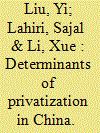

|
|
|
|
|
| Summary/Abstract |
This study investigates how the presence of foreign firms in a sector influences the privatization policy of domestic firms in that sector in China. We consider several variables to proxy for such a presence, from the perspective of the relative production scale, R&D and marketing, and labor productivity. By using the enterprise surveys carried out by the World Bank in 2005 of nearly 12,400 Chinese firms located in over 100 cities, we find that a rise in the presence of foreign firms increases the extent of the private ownership of domestic firms in a nonlinear fashion. Additionally, we apply IV-Tobit estimation with valid instruments and Tobit estimation with lagged key variables to deal with the possible endogeneity in the relationship between the presence of foreign firms and the privatization decision. Empirical evidence supports the main findings.
|
|
|
|
|
|
|
|
|
|
|
|
|
|
|
|
| 5 |
ID:
149777


|
|
|
|
|
| Summary/Abstract |
This paper examines the effect of the New Rural Pension Scheme (NRPS) on the labor supply behavior of the elderly in rural China. Using pooled data from two waves of the China Health and Retirement Longitudinal Survey (CHARLS) and an analytical framework of combination of regression discontinuity design and difference in difference method (RD-DiD), we find no evidence that pension receipt from the NRPS program does significantly induce the elderly to withdraw from the labor market. The heterogeneous effects by health status indicate that pension recipient slightly decreases the probability of labor force participation for those individuals with chronic diseases; however, the effect is not statistically significant. The empirical findings suggest that the introduction of the NRPS program does not improve the welfare effect of the originally targeted elder individuals with illness.
|
|
|
|
|
|
|
|
|
|
|
|
|
|
|
|
| 6 |
ID:
149766
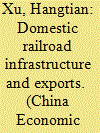

|
|
|
|
|
| Summary/Abstract |
By exploiting a quasi-experiment affecting only non-monetary transport cost, this study tests the impact of an exogenous railroad speed enhancement and capacity expansion project (RSCP) on China's exports to Central Asia. The Longhai and Lanxin lines in China, linking the East and the West, were upgraded on October 21, 2000, improving freight efficiency between Eastern China and Xinjiang, the gateway from China to Central Asia. By employing a transaction-level export database, empirical results find that exports freighted on the upgraded rail lines increased in value by approximately 30%, compared with other freight modes. The results are robust by excluding specific observations with respect to the demand fluctuations and macroeconomic shocks, and including additional controls. The intensive margin, but not the extensive margin, played a major role in explaining the impact of railroad upgrades on exports. In addition, the project caused spatial reorganization in exporting activities. The share of Xinjiang exporters in the Central Asia market shrank, while Xinjiang's exports to other international markets expanded through better accessibility to the coast.
|
|
|
|
|
|
|
|
|
|
|
|
|
|
|
|
| 7 |
ID:
149761


|
|
|
|
|
| Summary/Abstract |
In this paper, we exploit the negative educational shock caused by the Chinese Cultural Revolution to apply a regression discontinuity method in identifying the causal effects of education on health. While we find that better education reduces the probability of having poor self-assessed health and disabilities, we do not find statistically significant effects of education on the probability of having poor physical functioning status or uncomfortable body pains in the previous four weeks. Moreover, we find an interesting result that better education increases the probability of having chronic diseases. While most existing studies only identify the effect of education at a particular level, one contribution of our paper is that it provides estimates much closer to the population average effect. Moreover, our results imply that the underlying mechanism behind the effect of education on health might be different in developing countries from that in developed countries.
|
|
|
|
|
|
|
|
|
|
|
|
|
|
|
|
| 8 |
ID:
149762
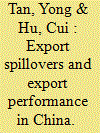

|
|
|
|
|
| Summary/Abstract |
This paper examines the local export spillover effect on the individual decisions to start exporting (the extensive margin) and export volume (the intensive margin), using a unique dataset of Chinese export firms, at the product-level and by destination country. Based on a gravity-type equation estimated at firm-level, we find that export spillovers positively influence not only the decision of a nearby firm to start exporting, but also the volume of the exporting. Several methods are used to verify the robustness of these results. In addition, we find that the effect of export spillovers is stronger when it is product-destination-specific than that when it is either product or destination-specific alone, and also stronger than that is in general. Geographically, local export spillovers exhibit spatial decay in China: the effect is stronger for firms located in the same city than it is for firms outside the city. Small and multi-product firms are more likely to be influenced by the local export spillovers, and their impact is stronger for firms exporting complex goods and exporting to easy-entry countries. Moreover, the export spillovers from private firms are the strongest, followed by foreign-invested firms with the effect generated by state-owned firms ranking last.
|
|
|
|
|
|
|
|
|
|
|
|
|
|
|
|
| 9 |
ID:
149757
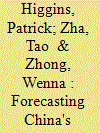

|
|
|
|
|
| Summary/Abstract |
Although macroeconomic forecasting forms an integral part of the policymaking process, there has been a serious lack of rigorous and systematic research in the evaluation of out-of-sample model-based forecasts of China's real GDP growth and CPI inflation. This paper fills this research gap by providing a replicable forecasting model that beats a host of other competing models when measured by root mean square errors, especially over long-run forecast horizons. The model is shown to be capable of predicting turning points and to be usable for policy analysis under different scenarios. We find that M2 supply, rather than interest rates, is a key variable for forecasting macroeconomic variables. Annual GDP growth for the next five years is predicted to be close to the 6.5% official target and a future GDP growth path is predicted to be of L-shape rather than U-shape.
|
|
|
|
|
|
|
|
|
|
|
|
|
|
|
|
| 10 |
ID:
149764
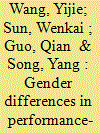

|
|
|
|
|
| Summary/Abstract |
We examined gender differences in performance-based pay in an institute of a top Chinese university, to provide insight into the gender earnings gap. We found that male professors earned more from research and less from teaching than did comparable female professors even though male and female professors showed no statistically significant difference in the total performance-based pay. Given the piece rate nature of bonuses in the institute and one's tendency to invest more time in areas where one has comparative advantages to maximize the total income, the study results lead to the conclusion that male professors displayed comparative advantage in research while female professors exhibited comparative advantage in teaching. The conclusion is corroborated by analyses of time allocation, and number of papers published as first author and as co-author.
|
|
|
|
|
|
|
|
|
|
|
|
|
|
|
|
| 11 |
ID:
149774


|
|
|
|
|
| Summary/Abstract |
Teachers can influence student achievement, not only directly, but also indirectly via peer effects. Based on a unique data set from a Chinese middle school (grades 7–9), this paper uses a student fixed-effects model to estimate peer effects for four core subjects (Chinese, Math, English, and Science) at the level of the class cohorts studying each subject. We find negative peer effects that are significant from both an economic and a statistical perspective. However, in the subjects taught by head teachers, who have more tools to manage students than do regular teachers, such negative peer effects disappear. Further investigation suggests that head teachers generate positive peer effects that override the negative ones.
|
|
|
|
|
|
|
|
|
|
|
|
|
|
|
|
| 12 |
ID:
149763
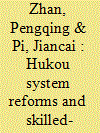

|
|
|
|
|
| Summary/Abstract |
In China, rural migrant workers usually cannot get fair treatment due to the hukou system. This paper investigates how hukou system reforms affect the skilled-unskilled wage inequality through the general equilibrium approach. In the basic model, we find that an increase in the strength of hukou system reforms will narrow down the wage inequality if the urban skilled sector is more capital intensive than the urban unskilled sector. In addition, we separately extend the basic model by introducing the endogenous minimum wage and an informal sector, and find that in these two extended cases the main results of the basic model will conditionally or unconditionally hold. When we consider some empirical evidences in China, our models predict that an increase in the strength of hukou system reforms will reduce the wage inequality.
|
|
|
|
|
|
|
|
|
|
|
|
|
|
|
|
| 13 |
ID:
149773


|
|
|
|
|
| Summary/Abstract |
This article analyzes the impact of education on income inequality between ethnic minorities and Han in China by using the data from the China Health and Nutrition Survey (CHNS) over the period 1993–2011. An instrumental variable approach using two institutional changes is applied to address the endogeneity of education in income equations for various subsamples. To investigate the impact of education on income inequality between ethnic minorities and Han, we introduce an interaction term between the ethnic minority status and years of education. Our results suggest that there exists significant income inequality to the disadvantage of ethnic minorities for the full, female, and urban samples, and depending on the instrument also for the rural sample. Nevertheless, our results for these samples show specific returns to education for ethnic minorities, which implies that a portion of the income gap can be overcome with additional education. We find that in general one additional year of education will increase earned incomes of ethnic minorities by 26.3–28% and in particular by 13.5–14.4% for women from an ethnic minority group, by 10.4–14% for ethnic minorities with urban household registration, and by 10.8% for ethnic minorities with rural household registration. However, we cannot obtain conclusive results for the male sample due to weak instruments.
|
|
|
|
|
|
|
|
|
|
|
|
|
|
|
|
| 14 |
ID:
149776
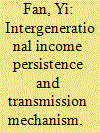

|
|
|
|
|
| Summary/Abstract |
In this paper I investigate the intergenerational income association and its transmission channels amid China's economic transition period using urban data from the Chinese Household Income Projects in 1995 and 2002. The estimated intergenerational income elasticity is 0.43 and 0.51 for cohorts educated prior to and after the market reform respectively, and reaches 0.71 among households with above average income in the post-reform era. Besides the conventional channel of education, this paper estimates the contribution from social capital and ownership of work unit across cohorts and income groups. There is weak evidence that prior to market reform, ownership of work unit contributes most to the intergenerational income persistence for households with below average income, while social capital leads the three contributors in households with above average income. However, in the post-reform era, parents with below average income invest statistically significantly in children's education which contributes most to the intergenerational income persistence. The leading contributor in families with above average income shifts to social capital. Possible explanations for such a shift lie in the ability and incentive of parents from different income categories to invest in their children. The results are tested through a series of robustness checks, and provide empirical support for promoting policies on the equality of opportunity.
|
|
|
|
|
|
|
|
|
|
|
|
|
|
|
|
| 15 |
ID:
149760


|
|
|
|
|
| Summary/Abstract |
This paper sheds light on how the growing number of off-farm employees affects the labor allocation of female and male left-behind farmers in the Chinese agricultural sector. We find no direct effect of off-farm employment on left behind workers' total working time in farming, nor do we observe a gender difference in this respect. However, we do find that increasing off-farm work is associated with fewer days worked on staple crops, and in the harvesting and sales stages of the production process. Hiring labor and buying agricultural services also impact left behind workers' time allocation. Moreover, we find that in China, contrary to several other developing countries, there is no trend towards a feminization of agriculture, but rather a tendency in the reverse direction.
|
|
|
|
|
|
|
|
|
|
|
|
|
|
|
|
| 16 |
ID:
149772
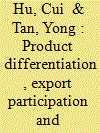

|
|
|
|
|
| Summary/Abstract |
In this paper, we investigate how the degree of export participation and product differentiation affect firms' productivity growth through learning-by-exporting. We extend the model of Melitz and Ottaviano (2008) to endogenize the effort firms allocate to learning. This effort choice depends on both the degree to which firms enter export markets and the extent to which products are differentiated across producers. Using a firm-level dataset from China's manufacturing industries, we implement propensity score matching methods to test the model's predictions. Our results indicate that the degree of export participation is positively correlated with TFP improvements. Simultaneously, we empirically verify that firms exporting less differentiated products experience faster TFP growth than those exporting more differentiated products.
|
|
|
|
|
|
|
|
|
|
|
|
|
|
|
|
| 17 |
ID:
149758


|
|
|
|
|
| Summary/Abstract |
We investigate how R&D subsidies affect business R&D investments using cross-section data of high-tech manufacturing firms in Jiangsu province of China. Our estimations based on propensity score matching suggest that public subsidies positively influence business R&D investments. Further classifying firms into different groups by size, financial constraints, and ownership, we find that the stimulation effect is more significant and stronger for smaller firms, more financially constrained firms, and private-owned firms. The heterogeneity of policy effects with respect to export status, Relative Comparative Advantage index, region, and industry are also discussed.
|
|
|
|
|
|
|
|
|
|
|
|
|
|
|
|
| 18 |
ID:
149769


|
|
|
|
|
| Summary/Abstract |
Applying the theories of heterogeneous firms and the propensity score matching difference-in-differences (PSM-DID) method to a rich dataset of Chinese manufacturing firms, this paper examines the self-selection of firm-level R&D input and estimates the net effect of R&D on productivity. The analysis shows that (1) for Chinese manufacturing firms as a whole, R&D input is influenced by firm productivity: more productive firms are more likely to invest in R&D; (2) controlling for the self-selection effect, the net output elasticities of R&D input in one year and two years after R&D input are 3.92% and 5.25%, respectively; (3) although state-owned enterprises (SOEs) are more likely than all other ownership groups to invest in R&D, the R&D input is not productive; (4) although enterprises owned by investors outside of Mainland China are the least likely to invest in R&D, the output elasticity of R&D is more significant and larger in this group than in SOEs and privately owned Chinese firms; and (5) surprisingly, the net effect of R&D is not significant in high-tech industries. Policy implications are derived from the findings.
|
|
|
|
|
|
|
|
|
|
|
|
|
|
|
|
| 19 |
ID:
149768


|
|
|
|
|
| Summary/Abstract |
Due to the pervasive nature of value chains, an increasing amount of imported intermediate components and raw materials from other countries are entangled in Taiwan's exports to Mainland China. This circumstance leads to odd across-trait bilateral trade amounts and surpluses favorable towards Taiwan. The purposes of this paper are applying Johnson and Noguera (2012) to extricate value-added exports earned by Taiwan from China and Wang, Wei, and Zhu (2013) to decompose Taiwan's gross exports to China into various meaningful components. The two issues are related to trade in value added and value added in trade. Specifically, the former explores the value added embedded in the source country's exports to the absorbing country as final demand, regardless of whether those goods are directly or indirectly arriving at the absorbing country. The latter only looks where the value added is originated regardless of where it is ultimately absorbed. We show both concepts aim to measure a country's value added from its trades, but from different angles. Each has its own distinct meaning. They are related, but not completely the same.
|
|
|
|
|
|
|
|
|
|
|
|
|
|
|
|
| 20 |
ID:
149771


|
|
|
|
|
| Summary/Abstract |
Since the end of the 1980s, the number of migrants working in the urban labor market has increased dramatically. However, migrant workers are treated differently from urban workers. In this paper we examine the labor market discrimination against rural migrants from the point of view of wage differentials using CHIP-2007 data. We apply Jann pooled method to deal with index number problem and use Heckman two step model to correct selection problem when decomposing the wage gap. The decomposition results show that a significant difference in wage gains persists between the two groups as late as 2007. In 2007 migrants only earned 49% of urban workers' income and 17% of the wage gap cannot be explained by observed factors. In detail, differences in educational attainment, work experience and distribution across industry, occupation, and ownership of enterprises account for most of the explained wage gap.
|
|
|
|
|
|
|
|
|
|
|
|
|
|
|
|
|
|
|
|
|